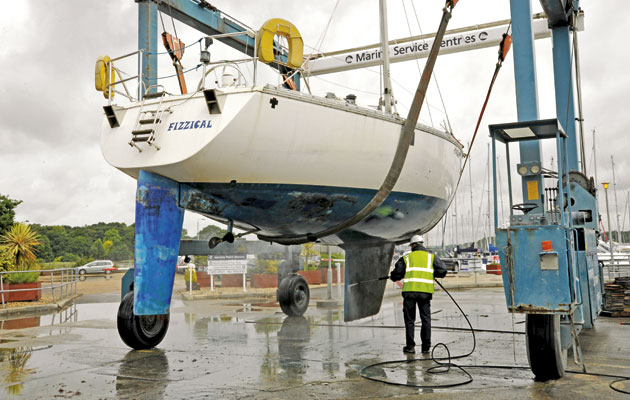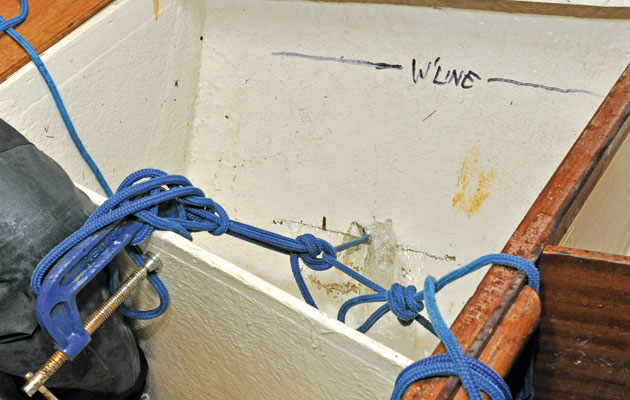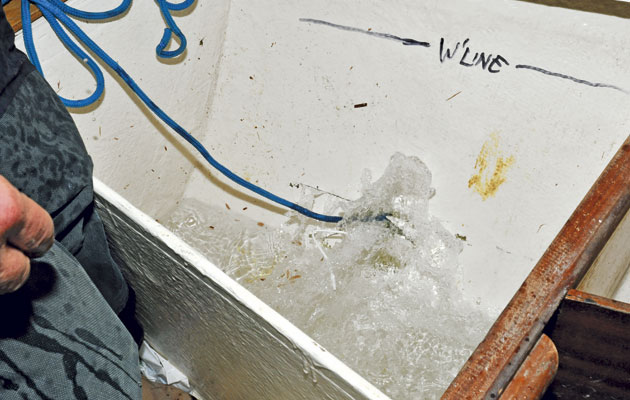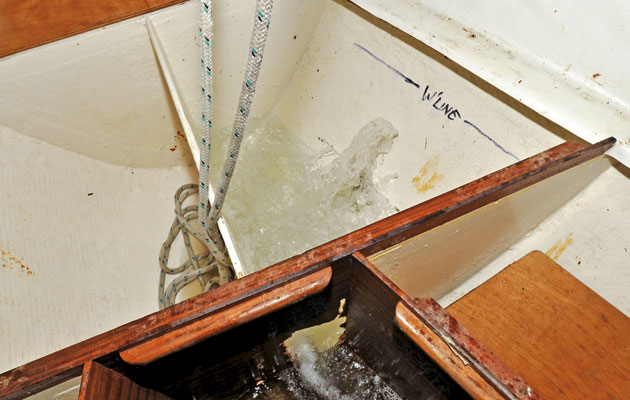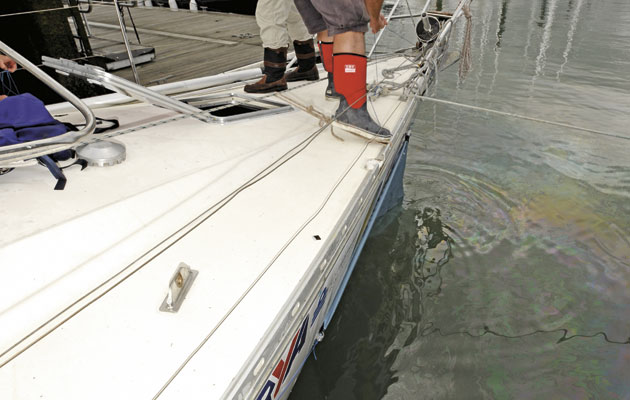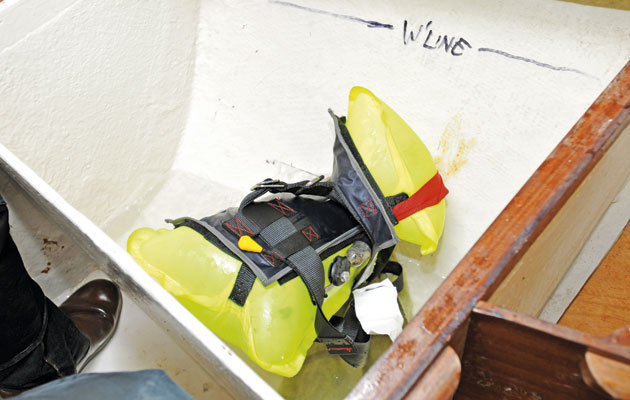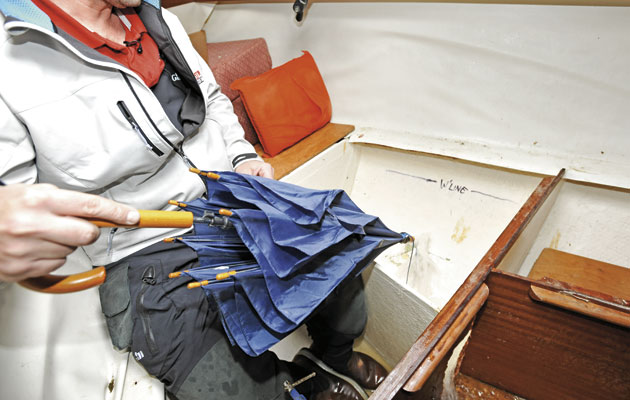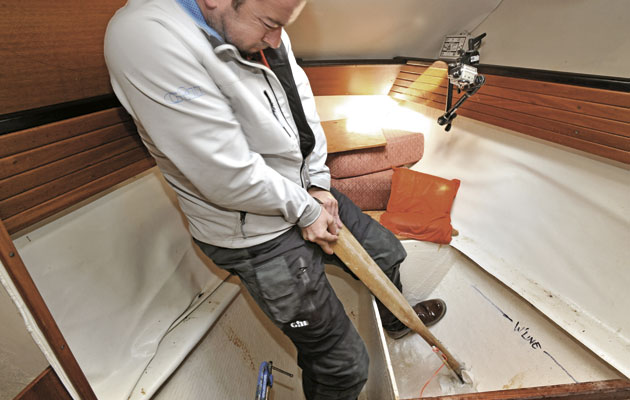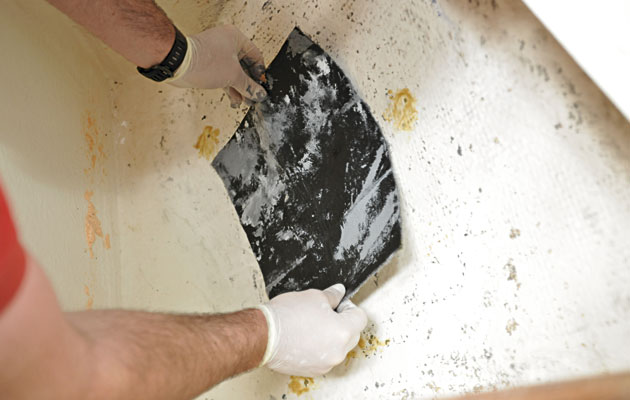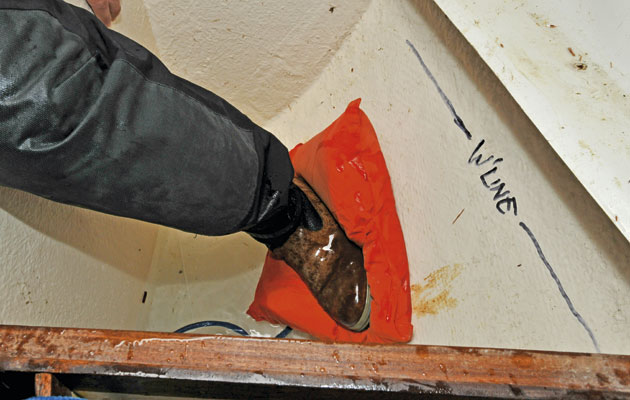You’re holed and sinking. What do you do next? Chris Beeson and the Crash Test Boat crew smash a hole in the hull to test 10 ways of saving a sinking yacht
Crash Test Boat – Holed and sinking
Whether it’s rocks, a floating log, or a shipping container, the chances of being holed below the waterline in a collision are remote. But as they say, accidents happen and worse things happen at sea, so we decided to put to the test various methods to stop a boat from sinking, in this case, the Crash Test Boat.
The chances are you’ll know about a collision the second it happens. Once you’ve picked yourself up, you will need to heave-to, as the damage is likely to be on the leeward side. Assuming there are two of you aboard, get your crew to prepare the grab bag and liferaft and then start using the manual bilge pump in the cockpit. If it’s not already working, switch on the automatic bilge pump and send out a DSC alert and a Securité message on the VHF radio. It’s important to do this first, before the water level rises enough to short out your batteries. Your hand-held VHF radio’s range will be much less.
Next, pull up the sole boards in the main fore-and-aft passage to expose the length of the bilge and check to see if water is flowing in. If it is, make a note of its general direction of flow, or check for changes in boat trim, and you’ll have a good place to start. It’s likely to be forward.
Empty lockers until you find the hole. If you have clear access, and the hole isn’t too big, stuff a cushion over it and hold it in place with your foot. This worked surprisingly well for us as a first response. If access is poor, clear any joinery with a hammer, then use the cushion. Now call your crew, assess the situation and plan your repair.
Test methods
The test required repeated ‘sinkings’ to assess the effectiveness of various repair methods, so we decided to ‘sink’ the boat using the slings of MDL’s Hamble Point Marina travel hoist. We lifted and drained the hull between each test to assess how effective each method had been. Had we not done this, the hole would soon have been below water, making this difficult. We chose to smash a hole in the hull under the forecabin bunk on the starboard side. To improve access for filming and photography, we removed both heads doors and the pillar between.
This had the benefit of making the hole fairly easy to get at. At sea, it’s quite possible that the hole would have straddled and partially destroyed a bulkhead. While the bulkhead would be easy enough to clear, the lamination at its joints would not, making any internal repair very tricky. In that instance, an external method of stopping the flood should buy enough time for a longer-term repair below.
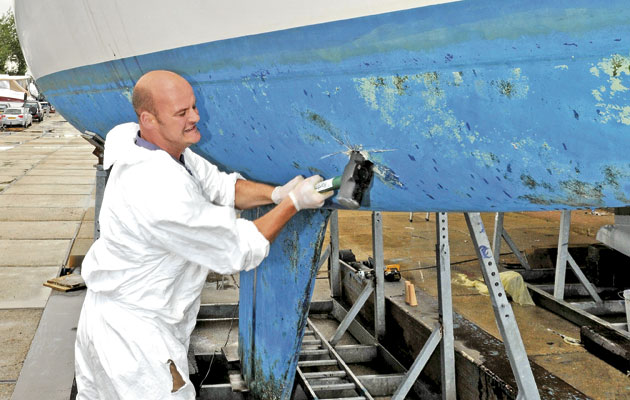
Using an angle grinder, a hammer and a chisel, it took Osmotech’s man 25 minutes to breach the Crash Test Boat’s hull
With the boat in a cradle, yacht repair company Osmotech UK set to work smashing the hole in the hull, which proved amazingly strong! The area inside the hull was first weakened by an angle-grinder, followed by 25 minutes of bashing with a lump-hammer. The hull’s resistance to being whacked with a 12 lb hammer was impressive, but a moving 7-tonne boat striking a rock would result in a quite different outcome. Finally, we had a hole roughly 8cm (3in) across, around 20cm (8in) below the waterline. The GRP shards were pushed into the boat to simulate collision damage.
To drain the bilge between tests, we drilled two 5cm (2in) holes either side of the keel, through inch-thick laminate, using circular drill bits. During tests, these were plugged from inside with wooden bungs.
We also knocked out some interior joinery in the forward cabin, to avoid concerns that water would flood only that sector to the waterline, then stop. This also allowed us to better assess how much water was flooding in – and demonstrated how easy it is to smash away interior woodwork to access a hole. Very easy, except for the lamination point at the hull.
The test was as valid as any of this type could be. After a collision, no two holes will be the same. Each will present different challenges but meeting them will require similar methods. We tested many ways to stop water flooding into the hull, some of which only occurred to us on the day. The big surprise was that, even with a small hole, in just seven minutes we had two tonnes of water inside the hull.
Two-stage testing
First, we explored emergency measures to stop the flood, buy time and regain control. For these, we used kit you would expect to find on an average cruising yacht. Then we tried out some ideas for making good a longer-lasting repair that would have enabled us to sail home – hopefully without continual pumping and bailing.
10 ‘buy you time’ repairs
1. Cushion stamped against the hole
As the boat was lowered and the water began to gush in, my first reaction was a sudden rush of adrenalin.
I grabbed a bright orange cushion, which has always lived in the forepeak of the Crash Test Boat, and held it over the hole with my boot. This took a second and greatly reduced the flow of water. It was a major confidence boost and definitely the quickest quick fix.
2. Flat plywood board
This involved using a coat hanger to push a loop of line out through the hole, which a crewman on deck snagged with his boathook.
He then inserted the line through a pre-drilled bunkboard, knotting the end to hold it in place, before I hauled the board from inside the boat, tight against the outside of the hull.
A G-clamp proved invaluable, providing a convenient anchor to tension the lines in this and other methods of stemming the flood. It took a couple of minutes to implement and the results weren’t spectacular.
3. Flat engine room board
A piece of engine room hatch, lined with sound-proofing sponge, was pre-drilled as the Mark II version of the flat plywood board solution.
Once again, a loop of line was pushed through the hole, which Kieran, on deck, snagged with a boathook and inserted through the board’s pre-drilled hole.
It took the same time to deploy, but was much more effective.
4. Fothering a sail
Tried and trusted by Admiral Nelson after cannon ball damage, this involved wrapping
a sail around the hull, leech forward as it’s smoother.
It was not quick. Lines needed attaching to each corner, then it needed a boathook to sink the sail under the hull’s knuckle. Twists needed to be removed before see-sawing the sail into place and securing very tightly to the toerail. Sadly, due to the sail’s built-in camber, it ‘pulsed’ against the hull, proving a decent fix one second, awful the next.
5. DIY collision mat
I tried to get a purpose-made collision mat, priced at £622 ($999), from an American company, but they never replied, so I spent £16.99 on a sheet of damp course membrane and £17 on four Strong Grips.
If not pre-prepared, it takes five minutes to assemble, longer than the sail. It also needed to be prodded under the hull’s knuckle but the flat, smooth material was see-sawed into place more easily than the sail and sat flat on the hull, stopping the torrent of water almost completely.
6. Lifejacket wrapped in a towel
This idea really appealed to me – fast and ingenious. At least, it might have been, with a bigger, rounder hole.
As it was, I needed to stuff the assembly through the hole with an oar, making the hole bigger and the gush of water worse.
Once in place, I fired the manual inflator and the flood slowed considerably. However, the inflation did open splits in the hull and water seeped relentlessly through them.
7. Umbrella
Always a bit of a long shot, this one, but worth trying if only to challenge the old truism about the two most useless things aboard a yacht being a retired navy officer and an umbrella. This one was a giveaway brolly from a newspaper promotion. I tied a line to the tip (to make sure the umbrella didn’t sink into the marina) and then prodded it through the hole.
When I tried to open the brolly, the handle fell off inside the hull. Looking at the shreds caused by the splintered GRP, it wouldn’t have worked anyway.
8. Subrella

The Subrella is out of production at the time of writing. Production volumes were not high enough to bring down costs
This is a purpose-made emergency collision ‘patch’ – a sort of hi-tech ‘umbrella’. As before, a line was tied on to prevent loss before it was thrust through the hole.
Because of the size of the Subrella and the relatively small hole, it had to be hammered through with the blunt end of an oar.
The hole was enlarged as a result but, once deployed with its safety line secured to the G-clamp, it slowed the flood to a level that would definitely buy you time. Alas, it is no longer in production and the patent belongs to a now defunct company.
9. Towel in a garden refuse bag
This idea aimed to exploit external water pressure by forcing a bagged item through the hole so that the water pressure could force it back against the hole, sealing it.
Unfortunately, the bag shredded as it was pushed through the jagged hole, leaving the towel prising the hole open and allowing water to gush in. It wasn’t an encouraging result and we perhaps overestimated the water pressure.
10. Sail in a sailbag
Again, the principle was to push the bag through the hole then stuff the sail into the external part of the bag so the water pressure could push it back onto the hull.
Again, the idea overestimated the water pressure and simply forced the GRP shards apart and opened the hole. The ingress can only be estimated from what was flowing out of the bulkhead, but it didn’t look at all encouraging.
5 ‘get you home’ repairs
Having established that our best quick fix was the DIY collision mat, that was the method we deployed to buy us time while we tested our ‘get you home’ repairs. We used an underwater epoxy repair kit designed for the purpose; a sheet of 2mm plywood coated with mastic and grease, braced against the hull; then the same sheet fastened to the hull with self-tapping screws. With the repair in place, we removed the mat to see how well it worked.
At sea, there would be no obvious reason to remove it but unless you get a tight seal at the sheet’s leading edge, it’s unlikely to last long once you get some way on. Covering the plastic sheet with a fothered sail would protect it from the seaway, improving its durability.
1. DIY collision mat
Did we need a more permanent repair? We wanted to test whether the DIY mat remained watertight under way. With neither engine nor mast, we asked the travel hoist crew to run the boat ahead and astern in the slings.
The mat leaked badly, but it wasn’t a good fother on this occasion and leaked whether moving or not, so I’m not sure we learned anything useful in this test. If you can’t get at the hole from inside the hull, you will have no choice but to get this right, and it is possible.
2. Braced board and cushion
It was difficult to shape the cushion to the hole. A thinner pillow worked better, but we didn’t have a bracing board small enough for the tiny orange pillow. Nor could we find a brace strong enough to exert sufficient pressure.
The deck broom was about to break so we used the boathook, which did break. We could have sawn the spinnaker pole, but to what exact length? Could we deploy it in such a confined space? Given plenty of time, it would have worked but we timed it out to try other methods.
3. Braced, bonded board
We slapped half a tub of Ramonol marine grease around the hole and squeezed a ring of fast-curing mastic onto one side of a 2mm marine plywood board. The plan was to brace this board over the hole using a cushion and bracing board, with the grease making a quick seal while the mastic cured to provide a more lasting seal.
Unfortunately, due to the bracing problems described, we never exerted the pressure required, the leak never stopped and the mastic never cured. Solve the bracing issue and this might work.
4. Bonded and fastened board
We tried nailing the same 2mm ply board in place, still covered in grease and mastic, but it was impossible to penetrate the hull. Self-tappers were also fruitless. We used a double-pinion hand drill because an electric one underwater wouldn’t work. Despite breaking a drill bit, we made five holes and, using self-tappers, screwed a 2mm ply board over the hole.
It worked well. Despite the grease, the board was beginning to ‘sweat’ after five minutes, so thicker ply, but still flexible, would be better.
5. Epoxy repair kit
The Kollision Kit is an underwater repair kit with a two-pack epoxy bonding system promising rapid cure.
Having keyed the surface with the wet-and-dry sandpaper supplied, I cut the mat to fit, mixed the two epoxy parts, spread the epoxy on the polymat and placed it over the hole.
Having braced it in place for five minutes, it created a very decent repair.
Under time pressure, I couldn’t mix all the epoxy, as it was difficult to spoon out of the pots, so I didn’t get the coverage I needed and, after a couple of minutes, a small leak appeared. In general, though malodorous and messy, it was very easy to apply.
What we learned:
You can save your boat
Being holed below the waterline presents a number of problems in a variety of scenarios, depending on the size and location of the hole, but you can almost certainly save your boat. During this test, a very clear action plan emerged and, with a few inexpensive, multi-purpose preparations such as the DIY collision mat and Strong Grips, the hand drill, some self-tappers, and the Kollision Kit, which can also be used for other repairs, there’s every reason to suggest that not only can you keep her afloat, you could even bail her dry.
The quickest fix
Stamping a pillow over the hole takes a fraction of a second and stems the flooding very well. It would be my first response, to buy time. Cushions are too resistant to shaping, as are sailbags, so I’d choose a small pillow every time. If you can brace the pillow in place, you’ll be free to move around, but we struggled to make bracing work. If you can’t get at the hole, move straight to the next step and get a sail or collision mat in place.
We used a damp course with Strong Grips and mousing twine to haul it into place. On reflection, I’d use a thicker line because the sheet needs to be taut, mousing twine cuts into the hands and is difficult to tie securely. We saw Strong Grips at Southampton Boat Show a couple of years ago. They’re supposed to be used for holding awnings and covers in place, but I thought they’d be ideal for this purpose. A waterproof tarpaulin would work instead of damp course, and it would have cringles already fitted.
If you’re holed either side of a fin keel, or you have a long-keeler, you’ll need to position the sheet on the damaged side of the centreline. Tie off the fore and aft upper lines to the toerail at a diagonal angle. With a fin-keeler, run the lower lines under the bow and stern, using a boathook to poke the aft line under the rudder and secure them on the opposite toerail. If you have a long-keeler, run the aft line under the counter and up to the opposite stern fairlead and the forward line under the bow and up to the opposite fairlead, and tie both off. Water pressure should take care of the rest, but be ready to seesaw the sheet into place and check below to see if it’s working.
Specialist kit
Our plan was to only use kit that you might find on the average cruising yacht. By and large, we managed to stick to that. One exception was the hand drill. We were lifting and draining the boat before the internal water level rose above the hole so that we could see the water gushing in and assess the effectiveness of each repair. At sea that’s not an option and it’s likely you’ll be working underwater, so an electric drill won’t work. Hammering is futile, so we spent £5.95 on a hand drill. It wasn’t especially easy to use, but we succeeded eventually.
The other exception was the epoxy repair kit. We had the perfect opportunity to test the Kollision Kit. It comes in a plastic case from Epoxy Solutions, a UK company. The Royal Marines, among others, use the kit to repair beach-damaged RIB hulls. It’s intended for external application, but I would never recommend readers leap overboard. Applying the required pressure around the repair outside would also be problematic. It can’t be used if water is flooding in, but as the collision mat had worked so well, reducing flow to almost nothing, we thought it was worth a shot.
Two tips: The rubber gloves supplied took ages to haul on, finger by finger. Use washing-up gloves instead. Secondly, the two epoxy parts ought to be supplied in tubes or syringes. With the adrenalin pumping, I wasn’t keen to fiddle around with the wooden paddles that were supplied, spooning out every last bit of epoxy. Unfortunately, when spreading it onto the polymat, I didn’t have enough to cover the edges completely and that’s where the leak appeared. My mistake but I’m sure it wouldn’t be an uncommon one.
It may not look much, but…
Flow rate mathematics is quite complicated but the estimates I found suggest that a 5cm (2in) hole 30cm (1ft) below the waterline will leak 300 litres (66 gallons) per minute. A 10cm (4in) hole at the same depth leaks 1,100 litres (242 gallons) per minute, enough to sink a 30ft yacht in 12 minutes.
We had an 8cm (3in) hole 20cm (8in) below the waterline. It may not have looked too threatening but in the first 7-8 minutes of the test, of which maybe 30 seconds was spent with nothing over the hole, displacement increased by 2,000kg, suggesting 2,000 litres (440 gallons) had leaked in, and the water was 5cm (2in) above the sole and 20cm (8in) above the bilge. When holed, response speed is of the essence.
Other tests in the Crash Test Boat series





